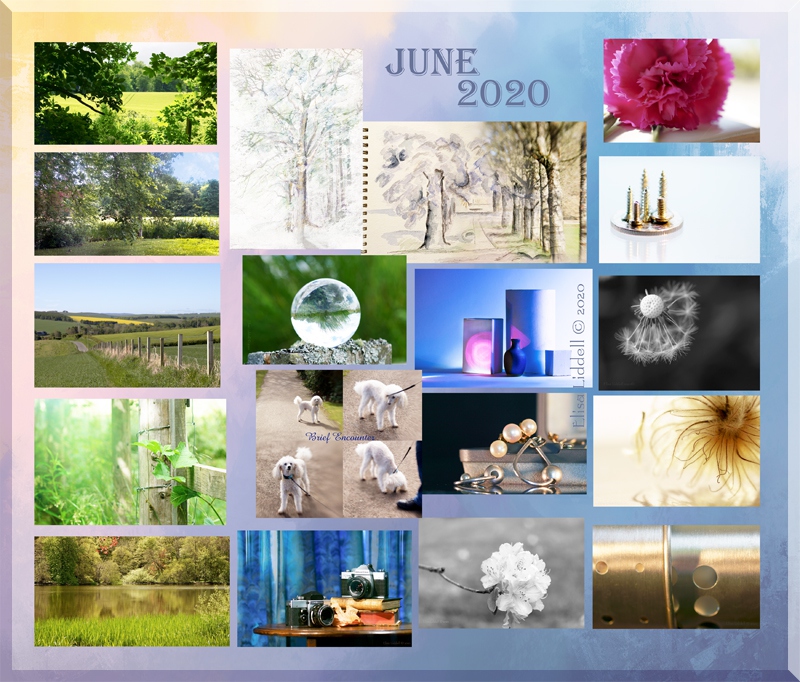
So June came – month 4 of the lock-down. Not seeing family and friends was not too bad, as we are scattered, so the phone, email and Facebook activity were our main ways of staying in touch. What we missed most of all was the freedom to go and walk by the sea, and in the grounds of the local National Trust Scotland sites, along with Historic Scotland and others. We live in the middle of farming land, where there is nowhere for humans to exercise and enjoy the outdoors. Walking a potato field is not fun!
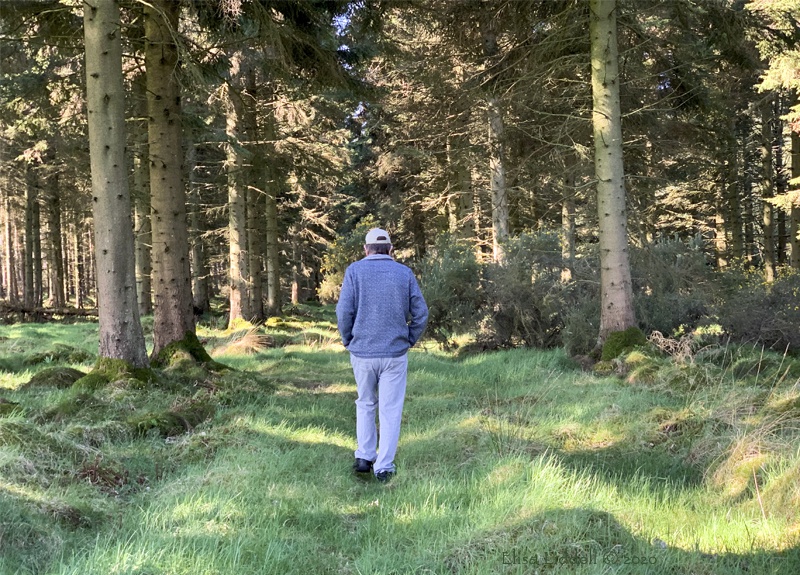
Trying to find alternatives to our regular sites for exercise and fresh air became a preoccupation as the weeks of Lock-down stretched out. It’s surprising how quickly your muscles become weaker with little or no regular exercise!

I took cameras with me wherever we went, and captured the hillocks and difficult terrain in infrared and colour too ….
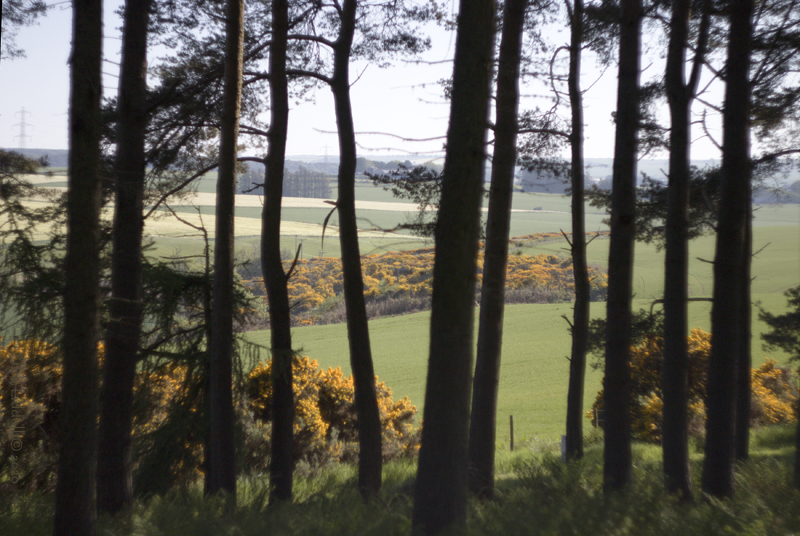
Another inhospitable location … difficult to walk without keeping your eyes firmly on the ground beneath your feet, as the danger of spraining or breaking your ankles was very real!
I don’t think the decision to close down the GROUNDS of the National Trust properties in rural areas like ours was a wise one. The grounds were never crowded, and they provided essential spaces for essential exercise! Even with a garden, our health was being impacted by the closing of places to walk safely!
Indoors I was having more fun, and success as I continued developing my painting. I wanted to use some of the thousands of landscape photos I have taken over the years. I don’t think I could ever find the energy and stamina to paint outdoors, so I have to rely on the photographs I take together with the memory of the observations I make at the time of shooting. So my starting point was the trees that are all around us here. It chimed perfectly with Cezanne, whose watercolours include many tree studies!
I started by using some of my infrared shots, as they can give the clearest definition of the architecture of the tree, the ‘bones’ that you often don’t see until winter strips away the leaves. Infrared reduces the foliage to white areas … which I could then paint in from memory or imagination. The idea worked quite well – but I didn’t like my attempts at the foliage!! But then I had an idea. How about putting the IR and painted pictures together, rather than just throwing my watercolour away? I had already used this technique to blend together several photographic images … how about using this technique to create such blends?
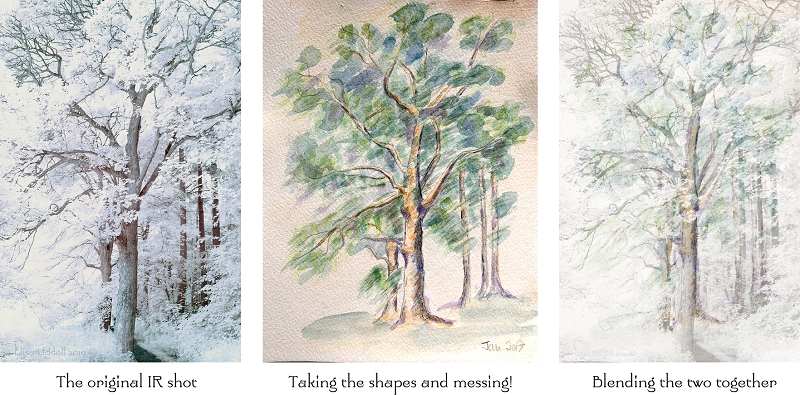
My first blending experiment gently wove the colours from the painting with the original infrared shot. So I pursued the idea – whenever I came across a Cezanne image that reminded me of a local scene, I tried to merge them. Here an avenue of trees at Fyvie Castle echoed an avenue of trees close to Ceazanne’s home in Aix.
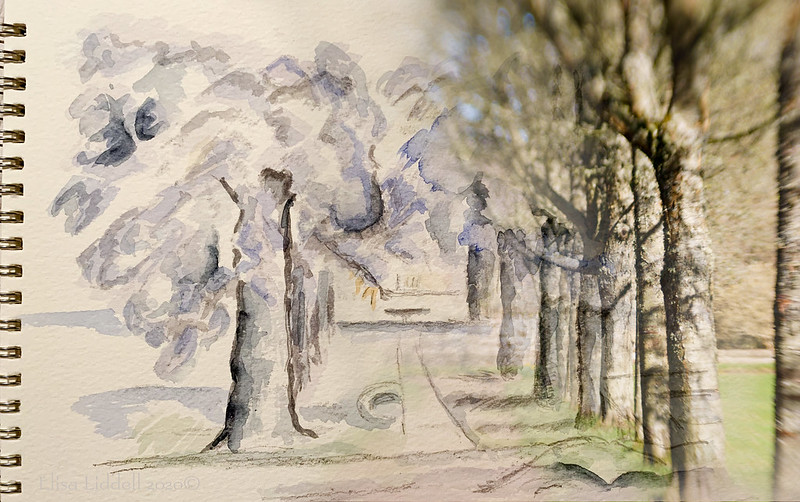
OK – a very amateurish watercolour sketch! But I liked the idea of weaving the images together!
The other ‘newcomer’ during these pandemic months has been the purchase of a Canon camera. I’m a Sony fan, and most of my cameras are Sony – so getting a Canon, even an ‘old’ EOS 70D was a big step for me. Learning the onboard computer was the biggest challenge I foresaw. There would be a learning curve, especially as I wanted to use it Manual Mode. My plan was to be able to create multiple exposure images within the camera itself. This is something Sony have not developed! So I set about learning my new camera.
I shot first of all on Auto, with the kit lens. Just shooting from the front door, looking out along the path into the garden was my first step. I then took some of the shots and blended them together in Photoshop, to get the feel of how in-camera multiple exposure might look..

As I looked at the result I realised I had (unconsciously) summed up the feelings of lock-down.
Next I moved on Manual Mode, and attached one of the lenses I wanted to use – an old Russian Helios lens that can give wonderful colours and bokeh effects. And this when I really stepped into foreign country!
All my Sony cameras use EVF, Elecrontic Veiw Finder. I hadn’t even heard of the alternative, the OVF or Optical View Finder. But WOW! was I about to discover what OVF means in practice!
Briefly with EVF I look through the view-finder and see what the result of my shot will look like. I can adjust the settings to make everything just how I want it to look, from focus to colour and light. What I see is what I will get! But the OVF just shows you what your eye is already seeing …. NOT what the shot you take will look like! You can adjust the focus – but otherwise you are ‘flying blind’. I found myself having to take a shot, look at it, adjust the settings and try again, and again, and again – before I could take the photo I wanted.
Imagine that you are walking down a tree-lined path, with dappled light, moving from strong sunshine into quite deep shade. With EVF I would simply look and adjust the image I see until I get an optimal balance of light values before taking the shot. Maybe 15 seconds to set and reset the camera. With OVF it takes me much longer and several test shots before I can take the final shot. No way to catch a fleeting light effect, to capture a swan suddenly coming in to land on the water! It felt like regressing to a much slower and clumsier age of photography!
Whether I want to shoot using the kit lens, or a specialist lens the problem is the same – to take multiple exposures I need to work in Manual Mode. So the problem remains. I need to shoot regularly and keep refining my skills and speed to reach my goal of making in-camera multiple shots!
On to July and a lifting of some restrictions!
Back to Journal Page
Back to Notebooks cover
Flickr holds Elisa’s online Photo Gallery
© 2020 Elisa Liddell
